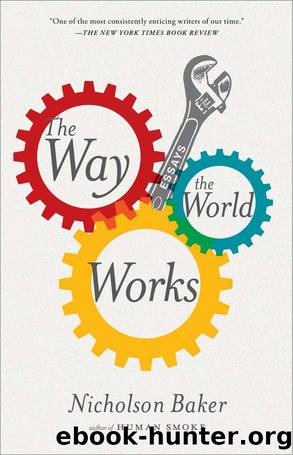The Way the World Works: Essays by Nicholson Baker

Author:Nicholson Baker [Baker, Nicholson]
Language: eng
Format: epub
Publisher: Simon & Schuster
Published: 2012-08-07T04:00:00+00:00
* * *
A review of The Flash Press: Sporting Male Weeklies in 1840s New York, by Patricia Cline Cohen, Timothy J. Gilfoyle, and Helen Lefkowitz Horowitz, in association with the American Antiquarian Society (University of Chicago Press, 2008).
Technology
* * *
Grab Me a Gondola
Twelve years ago, I stood on the steps of the church of the Gesuati with a ceremonial handkerchief in my suit pocket, and watched my soon-to-be wife set out with her father from the far side of Veniceâs widest and deepest-dredged waterway, the Giudecca Canal. The sky was the color of Istrian stoneâi.e., whiteâand the water looked choppy. Their boat leaned to one side (all gondolas lean, but I didnât know that then): sunk low among the silk-tufted cushions of their Byzantine conveyance, the passengers seemed to have their heads almost at water level. I worried that a large swell might slosh in unexpectedly from the side and capsize them.
The oarsman at the stern, Bruno Palmarin, had been endorsed by the local grocer. His grandfathers, his father, his older brother, and various uncles and cousins were gondoliers before him; members of the Palmarin family have rowed continuously since at least 1740. Nowadays, when Bruno does weddings, his nineteen-year-old son, Giacomo, is usually the second rower. Their boat is black, of course, in compliance with ancient decree (there is in fact a paint color called nero gondola), the oar blades are red-and-white-striped, matching the rowersâ wedding shirts, and over the sleeves of their white jackets they wear red armbands bearing the Palmarin family emblem (lion and palm tree) in four-inch lozenges of brass. Embellishing the gunwales are gilded cherubs that tug at bridles of black spiraling silkâthese replicate the fittings of the state gondola owned by King Victor Emmanuel III. Most gondolas have a proverb cast in a decorative ribbon of brass just in front of the passenger well. Brunoâs was written for his grandfather, Ambrogio Palmarin, by Gabriele dâAnnunzio, the poet: Ogni alba ha il suo tramonto (âEvery dawn has its duskâ).
Bruno doesnât row out onto the Giudecca Canal anymore unless a job like our wedding specifically requires it. When he was a boy, traffic on the canal was light enough that he could swim all the way across, returning on the traghetto, or two-oared gondola shuttle, that operated into the 1960s; but in recent years it has become a major thoroughfare, a sort of truck route, and its water is abob with the cross-purposed wakes of a vast range of boats: mid-sized motor-launches, ramp-prowed car ferries, crane barges, tugboats, tiny fiberglass speed-wedges banging from one swell to the next with a sound of lawn mowers, eight-story Greek cruise vessels thrumming past like insurance companies that have come laterally adrift, and oval, flat-roofed vaporetti swerving in loose S-shapes from shore to shore. Each spreading wave-system is reflected from the quaysides back into the central confusion. You may see ten boats, but you know that the water is mumblingly remembering the previous twenty-five. Only very late at night does the surface revert to its pre-propellerine calm.
Download
This site does not store any files on its server. We only index and link to content provided by other sites. Please contact the content providers to delete copyright contents if any and email us, we'll remove relevant links or contents immediately.
| Anthropology | Archaeology |
| Philosophy | Politics & Government |
| Social Sciences | Sociology |
| Women's Studies |
Cecilia; Or, Memoirs of an Heiress — Volume 1 by Fanny Burney(31374)
Cecilia; Or, Memoirs of an Heiress — Volume 3 by Fanny Burney(30968)
Cecilia; Or, Memoirs of an Heiress — Volume 2 by Fanny Burney(30922)
The Great Music City by Andrea Baker(22332)
We're Going to Need More Wine by Gabrielle Union(18108)
Bombshells: Glamour Girls of a Lifetime by Sullivan Steve(13140)
Pimp by Iceberg Slim(12972)
All the Missing Girls by Megan Miranda(12810)
Fifty Shades Freed by E L James(12478)
Talking to Strangers by Malcolm Gladwell(11948)
Norse Mythology by Gaiman Neil(11937)
Crazy Rich Asians by Kevin Kwan(8391)
Mindhunter: Inside the FBI's Elite Serial Crime Unit by John E. Douglas & Mark Olshaker(7873)
The Lost Art of Listening by Michael P. Nichols(6509)
Enlightenment Now: The Case for Reason, Science, Humanism, and Progress by Steven Pinker(6432)
Bad Blood by John Carreyrou(5799)
The Four Agreements by Don Miguel Ruiz(5551)
Weapons of Math Destruction by Cathy O'Neil(5072)
We Need to Talk by Celeste Headlee(4902)
